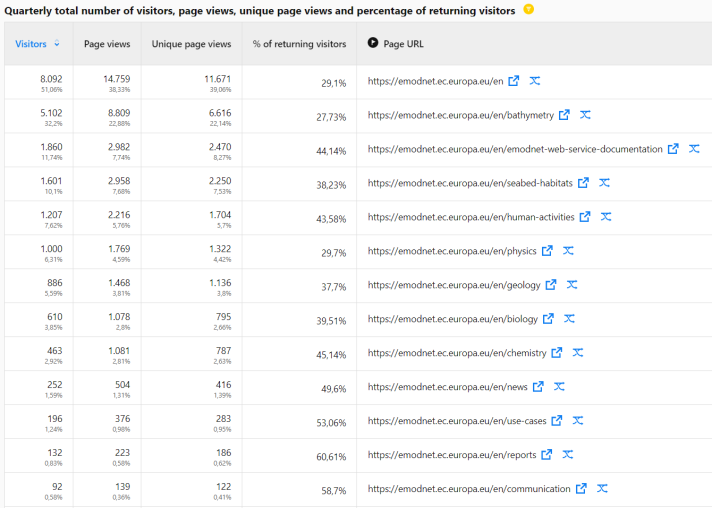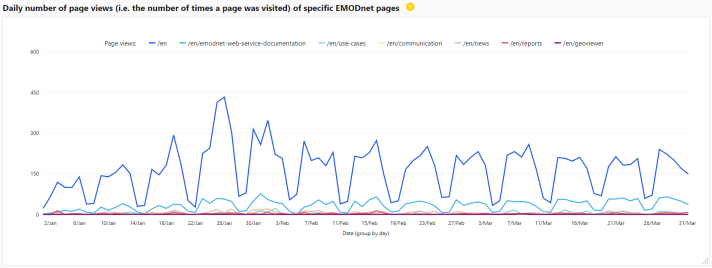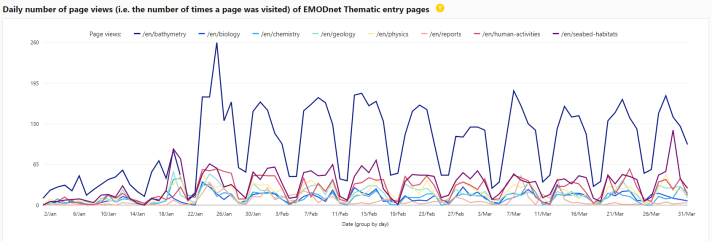EMODnet Secretariat progress update – 1st quarter 2023
This report provides an update of EMODnet progress made over the first quarter of 2023, and is based on the quarterly progress updates of the different EMODnet projects currently running (i.e. seven thematic lots, and one Data Ingestion facility) supplemented with updates from the EMODnet Secretariat. The summary below constitutes the fifth update since the start of the EMODnet Centralisation Phase (2022-2023) and refers to all activities developed within EMODnet for the period January-February-March 2023.
EMODnet progress overview
General progress highlights
On 25 January 2023 EMODnet reached a new stage as it launched its fully centralised marine data service, integrating all of its thematic services into one single portal. The move to one EMODnet Portal marks an end of the existing seven individual thematic portals which were switched off, and redirect to the EMODnet Central Portal. This thematic unification is a major upgrade, which simplifies access and enhances the EMODnet user experience. Central to the upgrade and major improvement is the release of the common map viewer, which offers the user easy and seamless access to discover, visualise and download marine data across seven thematics spanning marine environment and human activities and hundreds of data and data products from one place, powered by a searchable unified catalogue. As part of an overall external communication campaign, a public webinar demonstrating the upgraded EMODnet services took place on 16 February 2023 to which over 160 participants joined.
EMODnet Secretariat focused on preparations for the 13th Technical Working Group meeting, which was held as a hybrid event (in Brussels and remotely) on 4 and 5 April 2023.
In the reporting period, two new use cases were developed. The first use case was developed by the Flanders Marine Institute, coordinator of EMODnet Biology. It describes the guidelines developed on how to report imaging data (focusing on the specific case of plankton imaging) in a standardised manner. The guidelines contain recommendations to users of imaging instruments on how to format their data for submission to biodiversity international data portals following the OBIS-ENV-DATA format, a Darwin Core (DwC) based approach to standardise biodiversity data. The second use case was created by Energinet in collaboration with EMODnet Geology, and explains how Energinet used the Seabed Substrate map to avoid unsuitable areas such as mud basins for the development of offshore wind farms and energy islands in the Danish marine territory.
The EMOD-network participated in force at the second edition of the International Ocean Data Conference (IODC-II) on 20-21 March 2023. The EMODnet Secretariat’s technical coordinator Conor Delaney presented the recent EMODnet unification of services, and further talks identified EMODnet as a good example of an integrated and interdisciplinary Ocean Data System to address societal challenges. Jan-Bart Calewaert, Head of the EMODnet Secretariat, Chaired the first IODC session on Findable, Accessible, Interoperable and Reusable (FAIR) data, and was a panellist at a session on the UN Ocean Decade Data Coordination Group (DCG) and an update on the UN Ocean Decade Data and Information Strategy, to which EMODnet is an active contributor as co-Chair of the DCG. In the same week, EMODnet also participated in the International Oceanographic Data and Information Exchange (IODE) of the Intergovernmental Oceanographic Commission (IOC) of UNESCO’s 27th session on 22-24 March 2023, back-to-back with the IODC-II Conference.
Specific progress and achievements of the thematic data assembly groups
- EMODnet Bathymetry's contract was renewed for another two years (January 2023-December 2024). Data providers were re-activated resulting in a slight increase in number of Common Data Index (CDI) entries from 41,315 to 41,427. The consortium will work towards the development of a new Digital Terrain Model (DTM) by end 2024, for which the workflow will be as follows: (i) processing and pregridding new survey datasets and composite DTMs by data providers will start in September-October 2023; (ii) compilation and generation of the 12 regional DTMs by regional coordinators will happen in the first semester of 2024; (iii) integration and publication of the new 2024 DTM by end 2024. Further work will be done on updating the inventory of national baselines and coastlines and the best-estimate European digital coastlines for the three vertical levels. Finally, the GLOBE software and Collaborative Virtual Environment, both used by the data providers and regional coordinators, will be further upgraded.
- During the report period, EMODnet Biology updated existing 10 datasets, bringing in an additional 104,149 occurrence records. Three products (Species Distribution Models for invasive macroalgae; Presence/absence data of macrozoobenthos in the European Seas; R package: Btrait ‘Working with biological density, taxonomy, and trait composition data’) were published this quarter; the remaining products will be published in the course of April. The results of the Feasibility Study on Ecological Traits and sampling devices/methodologies identification with text mining, indicated that the most suitable models for the data management perspective are SpaCy and BioBERT. The first implementation of the semi-automated procedures to query, request, download and reformat data from SeaDataNet’s API[1] has been completed and is now operational, meaning that the thematic will from now onwards be able to more quickly publish biological data available through this aggregator, while spending less time with the reformatting.
- In EMODnet Chemistry, regional meetings have been planned with the data centres to discuss gaps in data delivery and the importance of delivering up-to-date data. Marine Strategy Framework Directive seafloor litter data related to the period 2012-2021 were harvested and are being prepared for delivery to the Joint Research Centre (JRC); efforts were dedicated to identifying data located in country waters. After the shutdown of the portal, the webODV service for viewing, extracting and exploring the eutrophication and contaminant data collections will be continued as an ’external’ service and is made accessible through the thematic entry page.
- During the reporting period, EMODnet Data Ingestion received 111 submissions, pushing the total number of received submissions so far to 1,419. The total number of published data submissions increased from 1,176 to 1,262. Furthermore, activities focused on upgrading the demonstrator service for providing access to real-time and near-real time observing stations; also the existing user interface to show newly connected stations and operators has been upgraded. Data Ingestion partners are focusing on developing easy connectors for oceanographic operators that are interested, next to the real-time viewer which serves as the phase 1 shop-window. Developments for connectors focus on ERDDAP[2], DAB[3], SWE[4] services, and OGC OM-JSON[5] based timeseries API. An EMODnet ERDDAP docker package is already available at Github to organizations willing to adopt it.
- A subcontract was signed between EMODnet Geology lead Geological survey Finland (GTK) and Azerbaijani partner Caspian Locus Limited Liability Company who immediately started with the work to access and harmonize data to the different work packages of EMODnet Geology. So as to incorporate also data from third parties from the Caribbean Sea area into EMODnet Geology, the thematic had discussions with Asociación de Servicios de Geología y Minería Iberoamericanos (The Association of Iberoamerican Geological and Mining Surveys; ASGMI), in which many local geological surveys are members. The local surveys of Colombia, Venezuela, Cuba, Costa Rica, Mexico, and the Dominican Republic already indicated that they have marine geological data, and are interested in cooperation with EMODnet. A cooperation kick-off meeting will be planned in Q2 or Q3 of 2023 where interested parties are invited to participate.
- EMODnet Human Activities updated a number of datasets (among others, Oil and gas licenses, Algae production sites, Marine Spatial Planning) as well as the Route density maps (updated to February 2023) and Vessel density maps for 2022). The thematic investigated possible new data products related to cultural heritage, based on data sent through Data Ingestion by the Marine Institute Ireland, in particular the World Heritage List of the UNESCO. Data from various partner countries were processed for new shellfish data products, as per recommendation from the Aquaculture Advisory Council to EC Directorate-General of Maritime Affairs and Fisheries (DG MARE).
- EMODnet Physics largely updated the River Outflow product. Furthermore, the lot is focusing on improving the data flow towards the new Central Portal interface. The Physics team proactively participated in a series of events and workshops on common standards and open data, among others the EuroGOOS (European component of the Global Ocean Observing System) Tide Gauge Task Team meeting, the Southern Ocean Observing System (SOOS) Data Management Sub-Committee (DMSB), and the Low Cost Technologies and Citizen Science in Ocean Data Collection event.
- The EMODnet Seabed Habitats team progressed well on the data preparation for the new version of the EUSeaMap (to be released towards Autumn 2023). The new EMODnet Bathymetry 2022 DTM allowed preparing depth-based input data, such as light availability on the seafloor. The habitat map submission guidance document was updated and will be published on the Central Portal in due course. Furthermore, the Seabed Habitats lot worked together with the Central Portal Technical Team to implement updates to the layer filters and download links on the map viewer layers, and to publish a new composite data product which was received through EMODnet Ingestion. Continued support was provided to the OSPAR data call for threatened and/or declining habitats.
EMODnet data portals usage
User visit statistics
Before the integration of the thematic data portals into the EMODnet Central Portal, when each thematic provided access to their thematic data, products and services through each of their respective web portals, user statistics (i.e. number of ‘unique’ page views and average visit duration) were collected through an EMODnet Matomo instance managed by the Flanders Marine Institute (VLIZ). Since centralisation and thus as of 25 January 2023 onwards, statistics on user visits to the EMODnet Central Portal are collected through Europa Analytics. Below we provide the daily number of page views[6] (in absolute number) of the EMODnet Central Homepage, a selection of pages, and each of the thematic entry pages.
Please note that since Europa Analytics was not yet used for collecting user statistics pre-Q1 2023, no information on trends are yet available for this quarter. It will be possible to report on trends from Q2 2023 onwards.
- A peak in the daily number of page views (433) was observed on January 26th for the Central Portal homepage, at the launch of the new portal. On average, the page containing web services documentation received between 50 and 70 page views per day.
- With regard to the EMODnet thematic entry pages, the entry page of Bathymetry was visited the most in the past quarter and as of 26 January, with on average around 170 daily visits during the week and a total of 5,100 visitors in the past quarter. The second most viewed entry page was the one of Seabed Habitats, followed by Human Activities, Physics, Geology, Biology and Chemistry. Total number of visitors equalled 1,601, 1,207, 1,000, 886, 610 and 463 respectively.
- It was observed that the pages on Web services documentations, Use cases, Reports and Communication had a high percentage of returning visitors (between 45 and 60%).
- For the various Central Portal pages as well as the thematic entry pages, it could be observed that most of the user activity took place on week days, with less activity during the weekend.
Going forward, it is expected the numbers on daily page views will increase, indicating at a multiplying effect of having a unified EMODnet system.
- The Data Ingestion Portal is not yet centralised, hence web traffic to their portal is currently still being tracked using Matomo and also AWSTATS. AWSTATS recorded an average of 250 page views in the quarter.
Statistics on usage of EMODnet portals[7]
For this quarter, we are seeing a change from reporting on metrics from the individual thematic portals to the metrics from the new unified portal. This affects the thematics in different ways, depending on their technical back-end infrastructure. Hence, for some of the thematics there is no download information available yet, or only partly. The new unified metrics are still being developed, and will be deployed over the next few quarters.
Number of data downloads[8]
- There was a decrease of 72% in number of downloaded CDIs from EMODnet Bathymetry compared to previous quarter, i.e. from 167,800 to 47,210 CDI downloads. The number of users decreased from 17 to 7.
- A decrease of 200% was recorded in the number of manual downloads of CDIs for EMODnet Chemistry (from 17,400 to 5,769 CDI downloads).
- EMODnet Data Ingestion recorded an increase in number of data download transactions, from nearly 232 to 350 (increase of 51%).
- Overall, number of data downloads decreased in EMODnet Human Activities; the sum of the number of dataset downloads equals 2,126 compared to 3,501 previous quarter. Among the most downloaded datasets were the Wind Farm locations (from 500 to 307 dataset downloads), Pipelines Actual Route Locations (from 230 to 182) and Cables Actual Route Locations (from 192 to 182).
- EMODnet Physics reported data download requests ranging between 0 and 94 (Atmospheric parameters respectively Temperature in the water column). No trends are available yet.
- Compared to the previous quarter, predominantly increases were observed in the number of data download requests for EMODnet Physics. A total of 425 data download requests were done, compared to 114 in the previous quarter. Download requests ranged from 0 (Atmospheric parameters), to 95 (River).
- For this quarter, EMODnet Seabed Habitats could only report on the number of manually downloaded records from the thematic portal when it was still live in the period between 1 and 26 January 2023. They observed 3,411,191 downloaded records of their dataset Collection of Classified Points.
Number of data product downloads[9]
- A decrease was recorded in the number of downloads of EMODnet Bathymetry DTM tiles (from 13,056 to 8,300 downloads) and an increase in number of High-Resolution DTMs (from 552 to 2,215 downloads). The Satellite Derived Coastlines were downloaded 7 times (compared to 69 in the previous quarter).
- For most EMODnet Geology data products, the number of data product downloads increased. Increases range between 130% (Events and Probabilities, Landslide susceptibility (from 109 to 251 file downloads)), 250% (Events and Probabilities, Vector data (from 20 to 70 file downloads) to 1,024% (Seabed Substrate, Multiscale (from 33 to 371 file downloads)).
- For this quarter, no data product download trends are available for EMODnet Human Activities due to centralisation and a change in the means of metric collection. About 1,329 Vessel Density Maps datasets were downloaded this quarter from the Central Portal map viewer (in the previous quarter, when the data products were still available on the thematic map viewer, 1,991 dataset downloads were done); and of the Route Density Maps, 815 dataset downloads were done (735 dataset downloads were performed in the previous quarter, from the thematic map viewer).
- Increases in the number of product download transactions through ERDDAP (from 256,480 to 4,202,618) were observed for EMODnet Physics.
- For this quarter, EMODnet Seabed Habitats could only report on the number of manually downloaded datasets from the thematic portal when it was still live in the period between 1 and 26 January 2023. Most downloaded product dataset was Habitats - seabed habitats (including coastal wetlands) - collection of classified maps (15,394 dataset downloads).
Upcoming EMODnet meetings and events
The main EMODnet meeting planned for the coming period in 2023 is:
- The 18th EMODnet Steering Committee meeting will take place on 22 May as an in-person event in Brest, France, back-to-back with the European Maritime Day 2023 which will take place on 23-24 May at Brest Expo – Parc de Penfeld in Brest, France. Come visit EMODnet at its booth!
- The Ocean Race, the most extraordinary and toughest around-the-world regatta involving more than 2 million visitors in the past edition, is gearing up for June's Grand Finale in Genoa, Italy from 27 to 30 June. ETT is supporting the race with a technical partnership and as part of the sponsorship, in collaboration with EMODnet Physics and Ingestion partners and sister projects (NAUTILOS, SOCHIC, OCEAN:ICE, EuroSea and others), is organizing “Ocean Data Hours” dedicated to sustainability, data FAIRness, cooperation. The program will propose events, roundtables and workshops that will lead to the Ocean Data Week.
More information
More information about EMODnet’s resources is available at the following links:
EMODnet Data and Data product portfolio: https://emodnet.ec.europa.eu/en/data-portfolio
EMODnet for Business brochure: https://emodnet.ec.europa.eu/en/emodnet-business-brochure
Thematic portals
EMODnet Bathymetry - https://emodnet.ec.europa.eu/en/bathymetry
EMODnet Biology - https://emodnet.ec.europa.eu/en/biology
EMODnet Chemistry - https://emodnet.ec.europa.eu/en/chemistry
EMODnet Geology - https://emodnet.ec.europa.eu/en/geology
EMODnet Human Activities - https://emodnet.ec.europa.eu/en/human-activities
EMODnet Physics - https://emodnet.ec.europa.eu/en/physics
EMODnet Seabed habitats - https://emodnet.ec.europa.eu/en/seabed-habitats
Data Ingestion Service
Ingestion and safe-keeping of marine data - www.emodnet-ingestion.eu
Sea-basin Checkpoints resources
For an overview of and access to information and outputs from each of the Sea-basin Checkpoints (projects ended), visit: https://emodnet.ec.europa.eu/en/checkpoints
North Sea checkpoint - https://emodnet.ec.europa.eu/en/checkpoint/north-sea
Mediterranean checkpoint - https://emodnet.ec.europa.eu/en/checkpoint/medsea
Artic checkpoint - https://emodnet.ec.europa.eu/en/checkpoint/arctic
Atlantic checkpoint - https://emodnet.ec.europa.eu/en/checkpoint/atlantic
Baltic checkpoint - https://emodnet.ec.europa.eu/en/checkpoint/baltic
Black Sea checkpoint - https://emodnet.ec.europa.eu/en/checkpoint/black-sea
[1] Application Programming Interface
[2] Environmental Research Division's Data Access Program
[3] Data Access Broker
[4] Sensor Web Enablement
[5] Open Geospatial Consortium Object Mapping JavaScript Object Notation
[6] The number of times a page was visited
[7] For thematics which provided this information.
[8] Disclaimer: please note that percentages given can reflect small as well as large changes in the number of data and data product downloads. In most cases however it is difficult to provide an actual explanation for the downloading behaviour of users.
[9] Disclaimer: please note that percentages given can reflect small as well as large changes in the number of data and data product downloads. In most cases however it is difficult to provide an actual explanation for the downloading behaviour of users.



